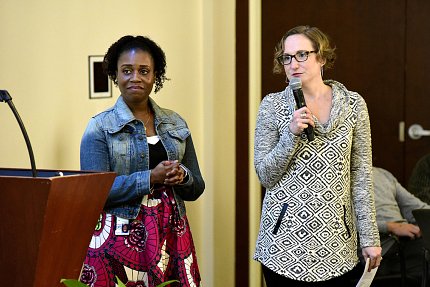Sound Health
Science and Music: A Meeting of the Minds

Photo: Steve McCaw
Can science tell us why we create music and how the art form might improve our health? Those questions—and live jazz improvisation—entertained a packed crowd at Music and Science. The recent lunchtime event was hosted by NIEHS and the Research Triangle Foundation.
Headlining the event were bassist John Brown, director of Duke University’s jazz program and professor of the practice of music, and Dr. Richard Mooney, professor of neurobiology at Duke. His lab studies the neurobiology of hearing and communication, with special emphasis on the neural mechanisms of vocal learning, production and perception.
Brown and guitar accompanist Kevin Van Sant opened with a jazz set. The discussion that followed touched on music’s mysteries and appeal, complemented by hard science.
Mooney, a classically trained guitarist, described the brain and ear connection as a closed loop—known as a recurrent network. The cochlea does more than just deliver sound. The brain, cochlea and internal chemistry work together to influence how we hear, from assisting active listening to amplifying sound. Musicality in speech is essential to communication.
“There are people who have lesions in the right frontal cortex who lose a kind of musicality, making their speech very hard to understand,” said Mooney. “Without emotional inflection and content, speech becomes almost incomprehensible.” He pointed out other ways music and the brain interact:
- Although Alzheimer’s patients struggle to remember, they can sing along effortlessly with songs from their childhoods.
- Cochlear implants have made it possible for the deaf to hear again, but because technological limitations result in low music spectrum sensitivity, which is necessary for appreciating music, they typically do not like to listen to music.
- Stutterers can sing fluently.
“There’s a lot of debate over whether there is some kind of innate predisposition to music,” said Mooney. “My guess is that it’s our way of exploring something our minds can’t get to any other way. Most people make music, whether they know it or not.”

Photo: Steve McCaw
Discussing improvisation, Brown and Van Sant both described it as an intuitive process that requires musicians to listen intently and be sensitive to minor changes in tempo and mood. “People often say there’s a connection between music and science that we don’t really understand,” said Brown. “Well, this is as tangible as it gets, breaking down how our brains respond to music, trying to put a finger on this connection.”
The lunch was part of the Sound Health Initiative, a partnership between NIH and the Kennedy Center that started in 2017. NIH has awarded $20 million over 5 years to support the initiative’s first research projects.—John Yewell
